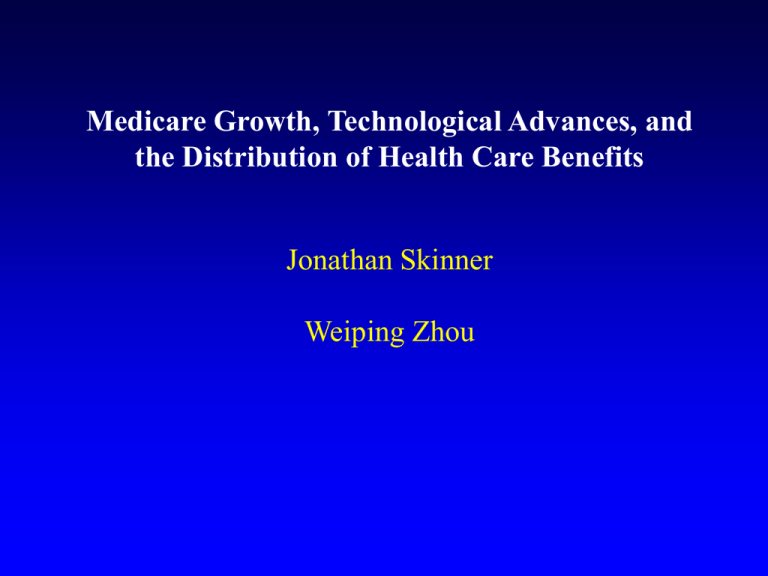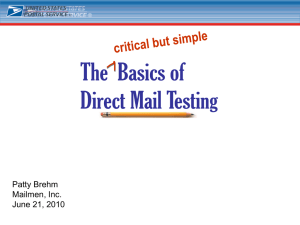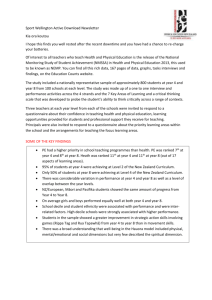Medicare Growth, Technological Advances, and the Distribution of Health Care Benefits
advertisement

Medicare Growth, Technological Advances, and the Distribution of Health Care Benefits Jonathan Skinner Weiping Zhou A Simple Question Have the billions of health care dollars spent during the 1990s improved or worsened inequality in health and wellbeing in the elderly population? A Not So Simple Answer Expenditures/utilization for health care: High income people get: • Less (Battachyaria and Lakdawalla, 2003)) • More (Le Grand, 1982; McClellan and Skinner, 2003, Sanchez et. al., 1992). A Not So Simple Answer Improvements in Outcomes: High education / nonminority people get • Less (McDermott, 1978) • More ( (Glied and Lleras-Muney, 2003; Goldman and Smith, 2002; Lichtenberg and Lleras-Muney, 2002) A Not So Simple Answer Improvements in Outcomes: High education / nonminority people get • Less (McDermott, 1978) • More ( (Glied and Lleras-Muney, 2003; Goldman and Smith, 2002; Lichtenberg and Lleras-Muney, 2002) How do you measure inequality in health or in full income anyway? Our Strategy • Expenditures: Fuchs proto-full income measure (Medicare expenditures plus adjusted CPS income) – Data sources: Current Medicare History Survey (CMHS), CPS Our Strategy • Expenditures: Fuchs proto-full income measure (Medicare expenditures plus adjusted CPS income) – Data sources: Current Medicare History Survey (CMHS), CPS • Outcomes: CMHS • Utilization: Cooperative Cardiovascular Project (CCP) data on heart attack patients (1994/95) Two measures of income: per capita family (CPS) and zip code (CMHS, CCP) Percentage Increase in Money Income 1992-2001 30 25 20 Low Income Middle Income High Income Percent 15 10 5 0 Money Income Full Income (1) Full Income (2) Percentage Increase in Full Income (1): Money Income plus Medicare Expenditures, 1992-2001 30 25 20 Low Income Middle Income High Income Percent 15 10 5 0 Money Income Full Income (1) Full Income (2) Medicare Expenditures (Males Age 80-84) 1987 and 1997, by Income Decile 8000 7500 1997 Medicare Expenditures 7000 6500 6000 5500 5000 1987 4500 4000 3500 3000 1 2 3 4 5 6 7 8 9 10 Income Decile Source: McClellan and Skinner, 2003 How Big is a Big Twist? • Decile 10 spending increase ($3300) less Decile 1 spending increase ($1600) 2000 1800 1600 1400 1200 1000 800 600 400 200 0 Medicare EITC How Big is a Big Twist? • Decile 10 spending increase ($3300) less Decile 1 spending increase ($1600) •Average EITC Payments per family receiving EITC (1997) Source: Brookings-Urban Website 2000 1800 1600 1400 1200 1000 800 600 400 200 0 Medicare EITC Average Home Health Care Spending By Decile 1987-2001: Men Age 80-84 in 1987 2500 2000 1500 1000 500 0 1997$ Lowest Income Decile Highest Income Decile Home Health Care Expenditures 1996 by Region Next Measure: Changes over time in Income Including Lifespan How Does One Place a Dollar Value on Lifespan Extension? Approach number 1: value gains in life-years for low income households by more (Cost-Benefit Analysis) Approach number 2: Value gains in life-years for low income households by less (Becker et. al. “WTP”) 10-Year Survival Rates Rose in Highest Income Deciles by More than in Lowest Income Deciles 0.82 0.8 1992-2001 10-year Survival Rate 0.78 0.76 0.74 0.72 0.7 1982-91 0.68 0.66 0.64 0.62 1 2 3 4 5 6 Income Decile 7 8 9 10 Percentage Increase in Full Income (2): Money Income plus Value of Life Extension, 1992-2001 30 25 20 Low Income Middle Income High Income Percent 15 10 5 0 Money Income Full Income (1) Full Income (2) A Third Approach: Focus on Utilization of “Effective” Technological Innovations Causes of 90-Day AMI Mortality Decline, 1975-1990 Source: Heidenrich and McClellan, 2001 Aspirin Beta Blocker Thrombolytics ACE Inhibitors Primary PTCA No Significant Impact: CABG, calcium antagonists, PTCA (non-primary), nitrates, anticoagulants, etc. Effective Care Following AMI: By Zip Code Income Beta Blocker ACE Inhibitor Reperfusion Smoking Cessation Advice Decile 1 40 57 32 33 Decile 10 47 59 37 35 Difference 7 2 5 2 Beta Blocker Use By Region Source: Dartmouth Atlas 100.0 80.0 60.0 40.0 20.0 0.0 Percent of “Ideal” Patients Receiving Beta Blockers at Discharge Following AMI (1994-95) Income per Capita in 2000 and Average 1-Year AMI Mortality (1989-2000) by State .02 MS AR LA WV TX OK NJ 6.94e-18 KY ALSC TN OH NCMOGA IN FL OR KS AZ MI IL -.02 NY MD VA MA WA WI IA ME CA NV PA RI ID DE NE CT MN NH CO -.04 NM ND WY VT MT UT -.06 SD 20000 25000 30000 35000 per capita income (nominal), 2000 40000 .02 Putnam’s Social Capital Index and Average 1-Year Mortality (1989-2000) by State MS TX KY ALSC TN NCGA 6.94e-18 OK AR LA NV WV NJ CA DE FL MD KS VA -.02 AZ OH MO MI IN ILNY PA NH OR RI MA WA WI CT IA ID MN NE ME CO -.04 NM ND WY VT UT MT -.06 SD -1 0 1 Soc Cap Index, Putnam 2 Medicare Expenditures (Age 70-74 M) by Year (1982-91 or 1992-2001) $1996 Expenditures 7000 Decile 1 in 1992 6000 Decile 10 in 1992 5000 4000 3000 Decile 1,10 in 1982 2000 1000 0 1 2 3 4 5 6 Year 7 8 9 10





